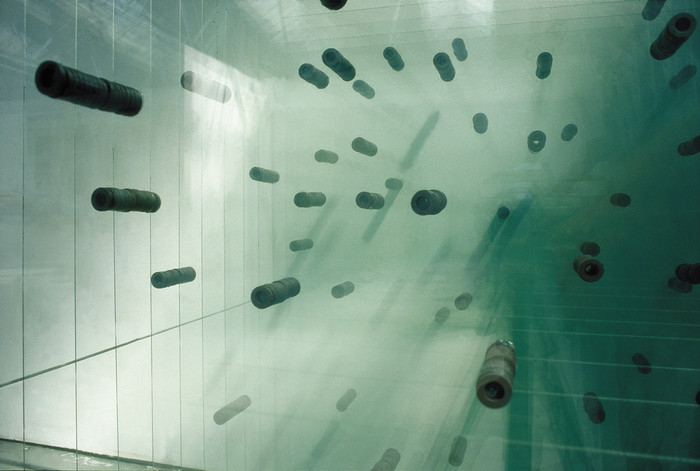Attila Csörgö - Magnet Spring
02 May - 20 Jun 2009
Galerija Gregor Podnar is pleased to announce the opening of the exhibition Magnet Spring, presenting early works created between 1991 and 1995 from Attila Csörgő together with his recent series Moebius Space.
Attila Csörgő’s work revolves around the appearance of changeable forms involving technology that plays with the viewer’s senses and ways of seeing, thus allowing him enter the realms inherent in permutable structures and perceptual states.
The earliest work on display is the Magnet Spring sculpture, from which the exhibition takes its name. This work from 1991 is composed of twelve panes of glass held together vertically by numerous magnets, letting the hockey puck-shaped magnets to seemingly float in the air. Another work from the early 90s entitled Drawing Machine (1992) Csörgő again employs magnetic forces.
Hidden by metal cuttings, a magnet draws its path on a pane of glass, powered by a turntable beneath the plate covered with cuttings.
From this same period, we will also present Landscape (1993), Pittura grande (1993), Slanting Water (1995) and Perspective Dice (1992-2009), photographs that are exploring various plays with the basic rules of atmospheric perspective. These works foreshadow the more recent photographic works of the artist, such as the Moebius Space series exhibited in Berlin.
Moebius Space is based on a camera, similar to Csörgő’s previous photographic devices and works Semi-Space (2001) und Orange Space (2003-2008), conceived in 2006 to produce photographic works in closed loops. The photograph recorded on the transparent Moebius plane is a special, round, inside-out panorama. The same motif appears on the strip’s two ends – upside-down on one of them – that fit together perfectly with a 180-degree twist. Due to the light-scan of the slit camera, this Moebius photographic space is not a snapshot. “It is created over a given span of time, and the resulting image, joined at the ends, can be seen as a plastic form with as many perspectives as we can view it from.” (Miklós Peternák)
Based in Budapest, Attila Csörgő took part at last years Sydney Biennial, in the 48th Venice Biennial in 1999 and the 8th Istanbul Biennial in 2003, as well as other well-known international events. In autumn 2009, his body of work will be shown in an extensive exhibition at Museum Ludwig in Budapest. Csörgő was awarded the Nam June Paik Prize in 2008.
Attila Csörgő’s work revolves around the appearance of changeable forms involving technology that plays with the viewer’s senses and ways of seeing, thus allowing him enter the realms inherent in permutable structures and perceptual states.
The earliest work on display is the Magnet Spring sculpture, from which the exhibition takes its name. This work from 1991 is composed of twelve panes of glass held together vertically by numerous magnets, letting the hockey puck-shaped magnets to seemingly float in the air. Another work from the early 90s entitled Drawing Machine (1992) Csörgő again employs magnetic forces.
Hidden by metal cuttings, a magnet draws its path on a pane of glass, powered by a turntable beneath the plate covered with cuttings.
From this same period, we will also present Landscape (1993), Pittura grande (1993), Slanting Water (1995) and Perspective Dice (1992-2009), photographs that are exploring various plays with the basic rules of atmospheric perspective. These works foreshadow the more recent photographic works of the artist, such as the Moebius Space series exhibited in Berlin.
Moebius Space is based on a camera, similar to Csörgő’s previous photographic devices and works Semi-Space (2001) und Orange Space (2003-2008), conceived in 2006 to produce photographic works in closed loops. The photograph recorded on the transparent Moebius plane is a special, round, inside-out panorama. The same motif appears on the strip’s two ends – upside-down on one of them – that fit together perfectly with a 180-degree twist. Due to the light-scan of the slit camera, this Moebius photographic space is not a snapshot. “It is created over a given span of time, and the resulting image, joined at the ends, can be seen as a plastic form with as many perspectives as we can view it from.” (Miklós Peternák)
Based in Budapest, Attila Csörgő took part at last years Sydney Biennial, in the 48th Venice Biennial in 1999 and the 8th Istanbul Biennial in 2003, as well as other well-known international events. In autumn 2009, his body of work will be shown in an extensive exhibition at Museum Ludwig in Budapest. Csörgő was awarded the Nam June Paik Prize in 2008.

